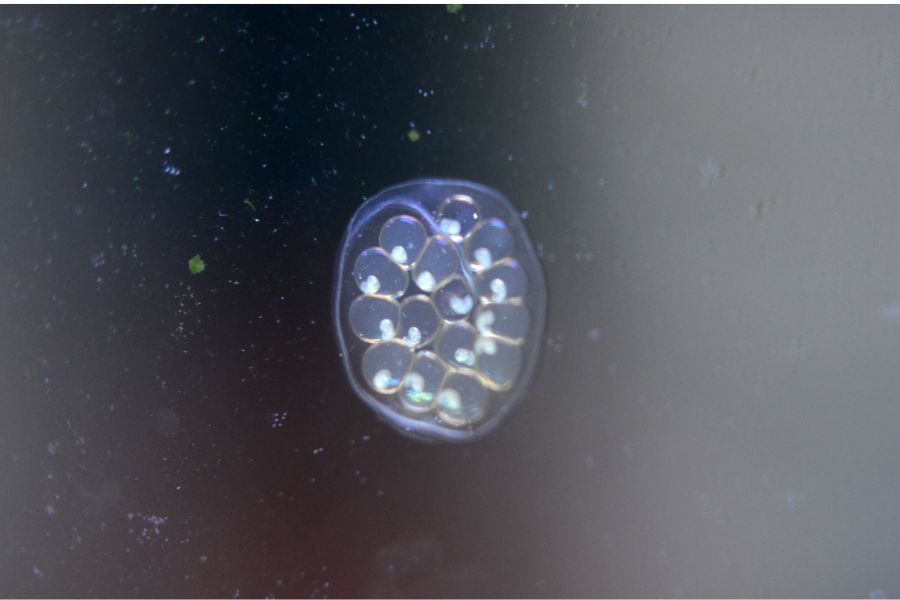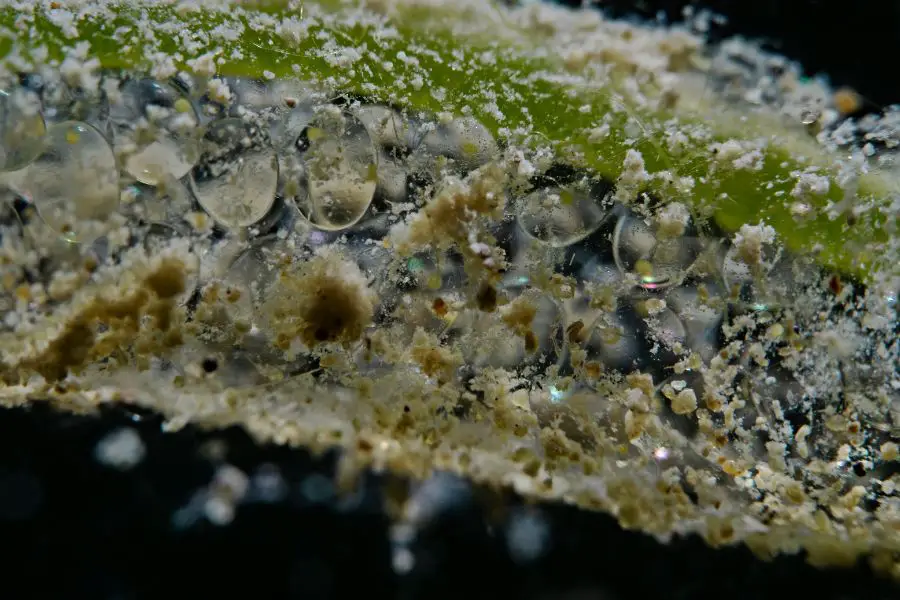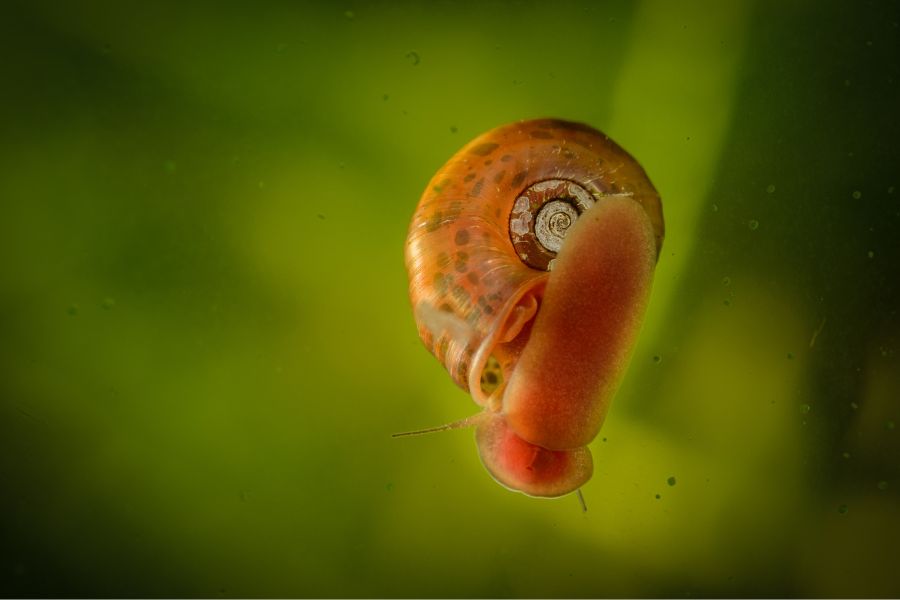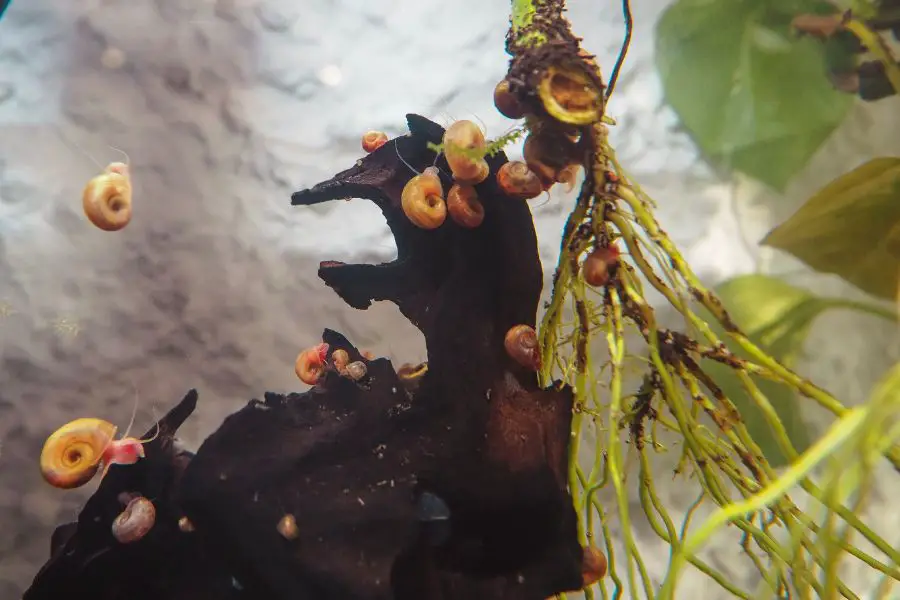Luckily, Getting Rid of Snail Eggs in Your Aquarium is not an impossible task. With the right tools and techniques, you can get your aquarium back under control.

Finding snail eggs scattered around your aquarium can be frustrating and unsightly. While some aquarists enjoy keeping snails, an out-of-control snail population can wreak havoc on your tank’s ecosystem.
When their population explodes, snails compete with fish for food and produce copious waste. Their eggs seem to appear overnight and stick to every surface imaginable.
This guide will walk you through the step-by-step process of removing snail eggs from your tank.
Identifying Snail Eggs
Jump To
Before you can remove snail eggs, you need to know what they look like. Snail eggs can come in a few different forms, but generally they appear as tiny translucent blobs dotted along glass, plants, decor and other surfaces.
They may be laid individually or clustered together in a gelatinous mass. The eggs of pond snails, ramshorn snails, and trumpet snails resemble clear tapioca pearls, while nerite snail eggs look more like small white dots.
Mystery snail eggs have a distinctive spiraled shape within their jelly-like casing. Regardless of the species, snail eggs tend to be small, roundish and clear or cloudy in appearance.
By familiarizing yourself with the visual characteristics of snail eggs, you’ll be able to spot them easily and take action before they start multiplying out of control.
Pay close attention to the undersides of leaves, aquarium walls and ornaments where snails often deposit their eggs. The sooner you notice new egg sacs, the easier they’ll be to eliminate.
Getting Rid of Snail Eggs in Your Aquarium: from Decor
Decorations and ornaments provide the perfect surface for snails to lay their eggs on. But thankfully, decor is also one of the easiest places to remove snail eggs from. Here are a few simple methods to clean eggs off your tank decor:
Take decorations out and scrub manually
Removing decor from the tank allows you to give the pieces a thorough scrubbing. Use an old toothbrush, algae scraper or paper towel to vigorously scrub off any egg sacs. Rinse well before returning decor to the tank.
Soak decor in bleach solution.
A diluted bleach bath will instantly kill snail eggs. Remove decor from the aquarium and soak in a 1:20 bleach-to-water solution for 1-2 minutes. Rinse extremely well and let dry fully before putting decor back.
Boil decor
Boiling decor for 5 minutes is an effective way to sterilize and deshell small ornaments. Make sure to let decor cool fully before reintroducing to your tank so you don’t shock your fish with hot water.
Use salt
Make a saltwater mixture and let hard decor soak for 12-24 hours. The salt solution will kill off any clinging eggs. Rinse several times before returning decor to your freshwater tank.

Removing Snail Eggs from Plants
Snails laying eggs on your aquatic plants can be trickier to deal with. You want to eliminate the eggs without damaging delicate leaves and stems in the process. Here are a few plant-safe options for removing snail eggs:
Pick off eggs.
Use your fingers or tweezers to gently pluck egg sacs off of plant leaves and stems. This works well for newly laid egg clusters that haven’t hardened on yet.
Dip plants in saltwater or alum.
A mild salt or alum dip can shock and kill snail eggs without hurting most plants. Mix 1-2 tablespoons of salt or alum per gallon of water and soak plants for 5-10 minutes. Rinse thoroughly afterward.
Use hydrogen peroxide
A diluted hydrogen peroxide solution can help dissolve egg clusters and kill snail embryos. Dip plants for 1-2 minutes in a mix of 1 part hydrogen peroxide to 4 parts water.
Do an acid bath
A brief diluted acid bath with white vinegar or lemon juice will kill snail eggs. Mix a ratio of 1 part acid to 4 parts water and soak plants for 1-2 minutes. Rinse extremely well afterward.
Quarantine plants
Keep new plants in a separate holding tank for a few weeks before adding them to your display. This allows time for any hidden eggs to hatch so you can remove the baby snails.
Removing Snail Eggs from Glass
The smooth surfaces of your aquarium glass provide the perfect spot for snails to attach their egg sacks. Here are a couple ways to remove snail eggs from the glass walls and bottom of your tank:
Use an algae scraper
An aquarium algae scraper with a razor blade is ideal for scraping off any eggs stuck to the glass. Just be gentle so you don’t end up scratching the glass surface.
Wipe with paper towel
If egg sacs are small, you may be able to remove them by wiping the glass with a paper towel or soft cloth. Try wiping in a circular motion to help dislodge clinging eggs.
Do a water change
Use a gravel vacuum to siphon water from the bottom of the tank. This will remove snail eggs and debris that have settled on the glass during water changes.
Scrape eggs above waterline
For clusters laid above the waterline, simply wipe them off with a paper towel or scrape with a plastic card. No need to dip your arm in the tank!
Preventing Future Snail Outbreaks
While removing current egg sacs will provide immediate relief, there are a few additional steps you can take to prevent future snail explosions:
- Reduce feeding: Overfeeding leads to more waste and algae for snails to eat. Stick to once daily, modest feedings and remove any uneaten food.
- Clean tank regularly: Use a gravel vacuum, trim plants, and wipe down surfaces to eliminate potential snail food sources.
- Get snail-eating fish: Loaches, pufferfish and clown loaches will eat small snails and help control populations.
- Use chemical controls: Snail-killing medications containing copper or potassium chloride can be used for severe infestations.
- Quarantine new plants/fish: Keep new additions in a separate tank for a month to check for hitchhiking snails or eggs.
Staying vigilant and addressing new snail egg sacs quickly is crucial for getting an infestation under control. With consistent removal efforts and preventive measures, you can successfully manage snail populations and keep their eggs from taking over your tank.

Methods to Remove Existing Nerite Snail Eggs
If your tank is already covered in nerite eggs, you’ll need to take steps to manually remove them. Here are some effective methods:
Razor Blade Scrape
A new, stainless steel razor blade can be used to carefully scrape eggs off surfaces like glass, decor, and driftwood. Gently rub the blade against the eggs at a 45 degree angle. The eggs should roll up and can then be removed with a spoon or during water changes.
Be very careful using a razor on acrylic tanks as it can scratch the plastic. Also use a light touch on driftwood, as the eggs can leave white blemishes if you rub too hard.
Algae Scraper
An aquarium-safe algae scraper with a sharp blade is ideal for removing nerite eggs from glass. The bumps and grooves many scrapers have help dislodge the sticky eggs. Just be gentle on acrylic.
For tanks with lots of driftwood or acrylic, an old credit card can work too.
Toothbrush
A clean toothbrush is a safer option for acrylic tanks and driftwood. Lightly scrubbing with the bristles will remove some eggs over time, though it requires more patience and effort.
Bleach Dip
Dip decorations covered in eggs in a 10% bleach solution for 2-3 minutes. This shocks the eggs off, but be sure to thoroughly rinse and dechlorinate before returning decor to the tank. Only do one item at a time.
Bleach can harm more delicate plants, so skip this method if you have them.
Stopping New Eggs Before They’re Laid
Removing existing eggs helps keep your tank looking clean, but addressing the cause of the eggs is the only way to prevent a constant recurrence. Here’s how:
Remove Female Nerite Snails
Identify the female nerite snails and take them out of the tank. Females have smooth antennae bases, while males have a small lobe. Without females, no more eggs!
This takes time and multiple snails to be sure though. An easier method is to isolate snails. If one lays eggs alone, it’s a female.
Replace any females removed with male nerites or different snail species for algae control. Make sure to quarantine new additions first.
Use Chemicals
Certain chemicals like copper effectively kill nerite snails, stopping egg laying. But these are toxic solutions that usually do more harm than good for your tank.
Natural chemical alternatives like calcium hydroxide (pickling lime) can work when applied correctly, but also alter water parameters.
Chemicals should be a last resort after trying everything else. They can have negative side effects.
Adjust Water Temperature
Increasing the water temperature by a few degrees can slow down nerite egg laying. But make sure the change is gradual and any tankmates can tolerate warmer temperatures too.
This method may not completely stop eggs, but can reduce the frequency.
Clean the Tank
Nerites lay more eggs in tanks with lots of algae growth and biofilm. Keeping the glass and decorations clean leaves less for them to eat and lays on.
Doing more frequent water changes helps reduce potential egg laying triggers too.

FAQs About Removing Snail Eggs
If you’re struggling with a snail egg infestation, chances are you have some lingering questions. Here are answers to some of the most frequently asked questions about eliminating snail eggs.
How do I get rid of nerite snail eggs?
Nerite snail eggs can be scraped off surfaces with a razor, soaked in bleach solution, or manually removed.
Their hard shells makes nerite eggs more stubborn than other snail varieties. Using fish like bettas and guppies that will eat the eggs can also help control populations.
What fish eat snail eggs?
Some fish species that will readily eat small snail eggs include: bettas, guppies, mollies, platies, clown loaches, pufferfish and some catfish like corydoras.
Why are there so many snail eggs even though I only have 1 snail?
A single snail can produce a tremendous number of eggs – up to 2,000 per month! And they have high reproduction rates. Even starting with a few snails, their population can grow exponentially if left unchecked.
How do I permanently get rid of aquarium snails?
Fully eliminating aquarium snails is difficult, but you can control populations by removing eggs, getting predator fish, adding copper medications if needed, and doing routine tank maintenance to remove food sources. Quarantining plants/fish is key to avoid hitchhikers.
What removes snail eggs from plants?
Gently wiping leaves, an acid or salt bath, and hydrogen peroxide can all remove snail eggs from aquarium plants. Pick off any larger egg sacs carefully with your fingers. Avoid using bleach solutions directly on plants.
Do snail eggs go away on their own?
Snail eggs won’t disappear on their own – they’ll simply hatch into more snails! The eggs must be manually removed or killed with chemicals/boiling water to stop them from developing further. Letting eggs remain leads to an ongoing snail takeover.
Conclusion
While snail eggs can be notoriously difficult to remove, this guide provides proven techniques to help you eliminate them from any surface in your aquarium.
Be thorough yet gentle as you manually wipe, scrape, soak and scrub decor, plants and glass to remove clinging egg sacs. Combine these removal methods with preventive measures like tank maintenance and snail-eating fish to stop future outbreaks.
With some elbow grease and persistence, you can eradicate persistent snail eggs and regain control of your tank. Just remember to work slowly and carefully to avoid harming your fish or fragile plants in the process. In no time, your aquarium will be sparkling clean and free of rapidly multiplying snail eggs.
Read Next:
